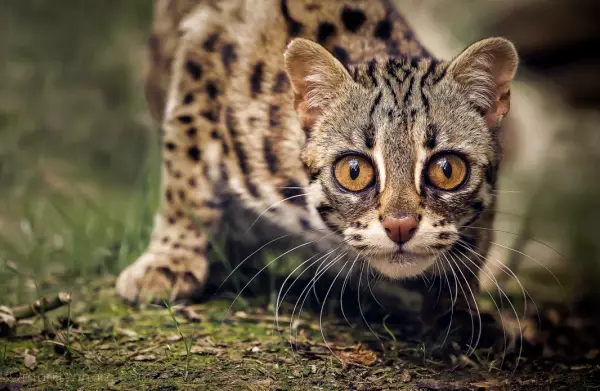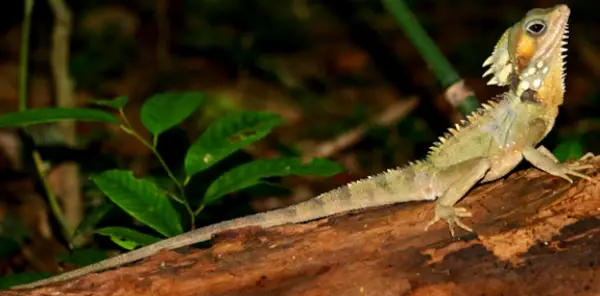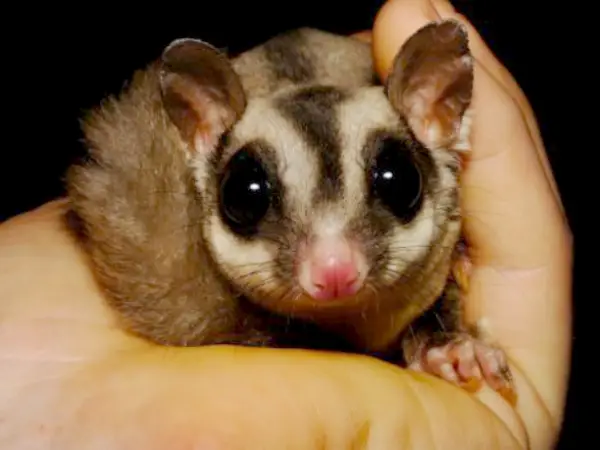Night Shift of the Rainforest – 9 Pictures + 1 Video
How many times have you heard people say “they are night birds”? This term is generally used for those who function better in the dark, just like these amazing nocturnal animals with habitat in the untouched nature of rain forests. They are characterized by night activity, food search, need for mating. We are accustomed to daylight and heavily dependent on our vision to determine what is happening around us. Once the night falls, our vision is limited to things illuminated by the moonlight. For us, that is a problem, but it’s just the right time for the vivid nightlife of a rainforest. Nocturnal animals, unlike us, have at least one highly-developed sense. Special “upgrade” includes large eyes, keen noses, big ears and sensitive whiskers, among other things. So, let's dive into the magical world of the rainforest nightlife.
Aye-Aye
The Aye-Aye is actually lemur that looks like a rodent, with rodent-like teeth that constantly grow and a specially adapted middle finger for food extraction. Aye-Aye is the world's largest nocturnal primate and spends most of its life high in the trees. They come down to the ground from time to time, but aye-ayes sleep, eat, travel and mate in the trees and are most commonly found close to the canopy where there is plenty of cover from the dense forest. During the day time, aye-ayes sleep in beds (much like nests) that are constructed and made of leaves and branches, before making an appearance after dark to begin their search for food. They commonly eat nectar, seeds, and fruits, but also insect larvae.
1 / 10

Dawn Bat
The Dawn Bat is a small Southeast Asian rainforest bat. Its extraordinary role in this rainforest ecosystem has only been uncovered recently. Dawn Bats have elongated and narrow snouts which give them a dog-like appearance. Their ears are small and pointed and their eyes are round and small. Believe it or not, these bats do exactly the same thing as the bees. Dawn Bats are night animals and they emerge from the caves at sunset to feed on pollen powder and nectar of night-blooming plants. Their favorite flowers are from the durian and mangrove apple tree. As the Dawn Bat hangs onto the flower and pushes its slim nose inside to lick the nectar, pollen covers its chest and face. They are the main pollinators of these trees and crucial for their survival.
2 / 10

Leopard cat
This cutie is a small wild cat native to continental South, Southeast and East Asia. Only slightly larger than its domesticated cousin, this fierce feline is known for its striking leopard-like spots. The Leopard cats belong to the endangered species since 2002. This amazing cat is a solitary hunter, hunting small mammals and birds at night. But anyway, the wild nature of this cat doesn’t diminish its cuteness.
3 / 10

Wallace’s flying frog
This awesome frog is able of leaping up to 50 feet (15 meters) between trees. We are talking about the high class Olympic long jumper. This is Borneo’s largest flying frog. Wallace’s flying frogs use their long specialized toe pads and long toes to glide through the night air. This amazing frog may be found in pig wallows, feeding on small invertebrates and various insects.
4 / 10
Emerald tree boa
This extremely vivid, non-venomous boa can be found in the rainforests of South America. It got its name because of the exceptional green color – the color of the emerald. They have a very strong tail which helps them to move through the branches. They spend their time during the day coiled over branches with their head comfortably resting in the middle of the coils. Like all other nocturnal animals they hunt at night, mainly small mammals and birds, but small reptiles and amphibians also can be found on their menu.
5 / 10

Boyd's Forest Dragon
Dragons exist! Not exactly the fire-breathing kind, but this one will not disappoint. His habitat is in Australia’s rainforests. Of the two rainforest dragons that exist in this rainforest, the Boyd's is a larger one. It has a body length of 15cm and a tail twice the length of its body. Boyd's forest dragons are sit-and-wait kind of predators and they are excellent in the art of camouflage. Their diet consists of invertebrates and earthworms.
6 / 10

Slender Loris
The Slender Loris is a small, nocturnal primate. It can be found only in the tropical rainforests of Southern India and Sri Lanka. They like thick and thorny vegetation where they can easily escape predators. Their menu consists of a variety of insects that are found in the dense undergrowth. Destruction of tropical rainforest habitat is contributing to decline in their population.
7 / 10

Tarsius
Tarsius is a small primate native to Southeast Asia. Tarsius live in small groups of two to seven members. They mostly move by vertical clinging and leaping and have a strict live-animal diet, mostly eating insects with some small vertebrates. Their lifespan is about 15 years.
8 / 10

Sugar Glider
The sugar gliders are very exotic animals, they live in rainforests of Australia and Indonesia. They are named after their diet and ability of gliding. They mostly eat sugary fruit and vegetables. The sugar gliders also have a tissue-like membrane between their ankles and wrists. This lets them glide between the trees. Their hearing is excellent which allows them to hunt insects and rodents in the dark.
9 / 10

Eyelash Viper
The eyelash viper is a venomous, nocturnal snake found in tropical rainforests of Central and South America. They are named after the modified scales over their eyes which resemble human eyelashes. Most of the time they are coiled up around small tree branches. They only hunt at night. They use their venom to kill the prey. Hemotoxic venom of eyelash vipers is fatal to the humans, too.
10 / 10

Image sources:
- bit.ly/2sEIF24
- bit.ly/2tIS0L8
- bit.ly/2tClVUZ
- youtu.be/FYj4RP_WfJE
- bit.ly/2tJ4pyQ
- bit.ly/2tisqty
- bit.ly/2ui4KW9
- bit.ly/2tCe2ii
- bit.ly/2tEAYwW
- bit.ly/2sz7Yra
